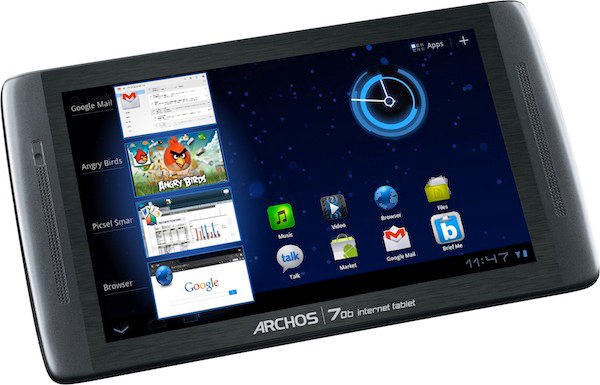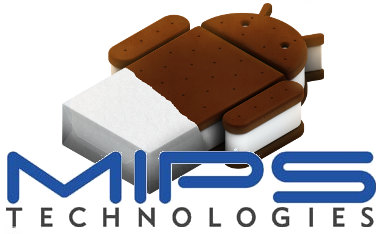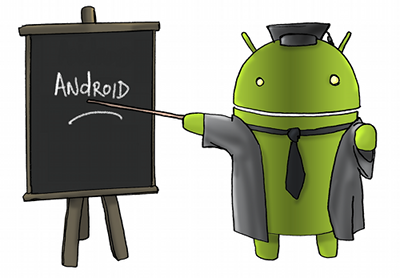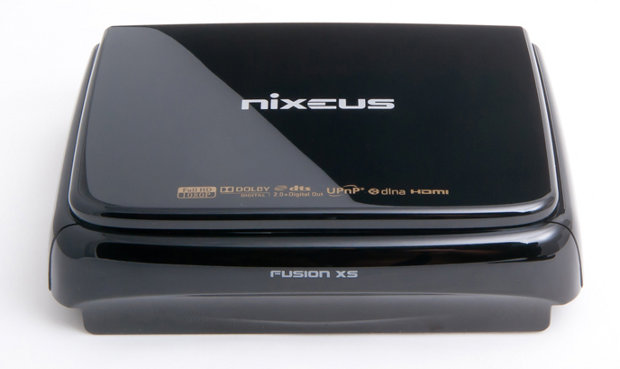Back in October, Archos released the GPL source code for Archos G9 Tablets and at the time the Special Developer Edition (SDE) was not released even though it is available for G8 devices. Now the SDE has still not been officially released, but I found a forum post on XDA Developers Forum explaining how the SDE Menu could be enabled by following the instructions below. Root your device with Paul O’Brien’s root here. (it won’t work if the device is not rooted) Unzip the content of gen9_enable_sde.zip to a directory. Launch the script enable_sde. Reboot into recovery mode, you should have the SDE menu now, you can flash your own kernel+initrd the same way it was done on previous generation. One trick: the initramfs should be still named initramfs.cpio.gz, but it should be compressed with lzma with current kernel. Another trick: to get rid of paul’s root as it messes up […]
Archos 70b Internet Tablet: 199 USD Android 3.2 Tablet
Archos announced the 199 USD Archos 70b Internet Tablet (Archos 70b IT) , a 7″ Android 3.2 (Honeycomb) based on a 1.2GHz processor (probably OMAP3630) with 512 MB RAM, and offers a 1024 x 600 capacitive touchscreen, 8GB of storage, HDMI output, and support for Google apps and Android Marketplace. Archos product naming is rather confusing, as they also have an Archos 70b running Android 2.1. So if you go shopping for the new device, make sure it reads Archos 70b Internet Tablet and not just Archos 70b. The Archos 70b IT is an enhanced version of the Archos 70 G8(Generation 8). The CPU (OMAP3630 Cortex-A8 processor) clock rate has been boosted from 1GHz to 1.2GHz, RAM has doubled to 512MB, the resolution resolution has increased to 1024×600 (was 800×480) and the price has dropped to 199 USD from 275 USD. Other features remain the same, as the tablet features […]
Bsquare Releases TestQuest 10 for Android and Windows Embedded
BSQUARE announced the availability of TestQuest 10, a new test automation technology suite that brings together key features of TestQuest Pro (automated test solution for embedded systems) and TestQuest CountDown (mobile devices and applications testing) and adds new functionality to create a new and powerful test automation solution, that aims at reducing test costs and complexity. Here are TestQuest 10 highlights: Reduces per test pass costs and complexity of test case development by integrating with popular tools Scalable automation enables test case reuse across multiple devices increasing execution accuracy Supports test execution on desktop prototypes, emulators and simulators enabling test execution to start before production hardware is available Supports testing for devices running on Android and Windows Embedded platforms Improved intelligent text recognition and language capabilities — up to 92% processing speed improvement TestQuest 10 is comprises of three components: Test Designer – Creates automated tests quickly for test case […]
Adobe Flash Player 11.1 now Supports Android 4.0
Adobe has recently release an update of its Flash Player for Android, which now supports Android 4.0 (ICS). Flash Player 11.1 is available for download on Android market. Android ICS will be the latest Android version with support for flash, as Adobe has announced it would discontinue developing Flash past 11.1 on mobile platforms. Adobe will also release AIR Android 3.1.0.556 and AIR SDK for Android 3.1.0.488 later this week. Adobe AIR is the runtime that enables developers to deploy standalone applications built with HTML, JavaScript, ActionScript, Flex, Adobe Flash Professional, and Adobe Flash Builder across platforms and devices. The update brings Flash to 11.1.112.60, and apart from Android 4.0 support, it does not bring any other new features, security enhancements or bug fixes. Adobe still lists some know issues: Seeking while video is paused will not update the frame on ICS device StageVideo using On2 and Sorenson does not […]
Android 4.0 Source Code For MIPS is Now Available
In the last few weeks, MIPS has already released the Linux Kernel for MIPS Android and shown us a low cost (99 USD) Android ICS Tablet. Today, they announced the official release of MIPS Android 4.0 source code. The latest version of Android 4.0 is “mr0″ and you can read the release notes for further details. Before downloading the Android source code be sure that you have a correctly setup Linux workstation. Now, here are the instructions to checkout MIPS Android 4.0:
|
1 2 3 4 |
mkdir mipsandroid cd mipsandroid repo init --repo-url=git://github.com/MIPS/repo.git --repo-branch=stable -u git://github.com/MIPS/manifests.git -b mips-ics-mr0 -m mips-ics-4.0.1_r1m1.xml repo sync |
The first time you run the repo sync it will download several gigabytes of source code to your machine so be patient and it may take a few hours. Once the download is completed future updates may take only a few minutes since only the code changes are downloaded. If you just want to have a look, All MIPS Android source code can also be viewed online at http://www.github.com/mips. […]
Android Training & Tutorials
The Android team just announced the launch of Android Training a collection of classes aimed at helping developers to build better Android applications. Each class explains the steps required to solve a problem, or implement a feature, with code snippets and sample code. They’ll add more materials over time, but right now developers can already learn (more) about the following topics: Designing for Multiple Screens Improving Layout Performance Managing Audio Playback Optimizing Battery Life Remembering Users Sharing Content Capturing Photos Maintaining Multiple APKs Developing for Enterprise Monetizing Your App Designing Effective Navigation There are currently 34 lessons on all those topics, and most include code samples such as the News Reader (Designing for Multiple Screens). You can get started immediately by visiting Android Training page. Jean-Luc Aufranc (CNXSoft)Jean-Luc started CNX Software in 2010 as a part-time endeavor, before quitting his job as a software engineering manager, and starting to write […]
Nixeus Fusion XS (NX-500) Network Media Player
Nixeus Technology announced the Nixeus Fusion XS, an Android 2.2 media player based on a dual-core Marvell Armada 1000 SoC (Cortex A8) with 512 MB RAM selling for 170 USD. The device supports 1080p playback, features a web browser and third-party Android app downloads. The Nixeus Fusion XS Network Media Player also includes a an Ethernet port, two USB 2.0 ports, an HDMI port and audio I/O. Here are Nixeus Fusion XS media player specifications: Processor Marvell ARMADA 1000 (88DE3010) – Dual Sheeva RISC CPU Process @ Up-to 1.2GHz Media Format Movie Video Containers: .avi, .wmv, .mpg, .iso, .vob, .ifo, .mp4, .asf, .tp, . ts, .m2ts, .mov (H.264), .mkv, MOTION JPEG Video Decoder: MPEG 1/2/4 SD/HD, AVI, H.264 HD, WMV9, VC1, Resolution up to 1920 * 1080p Music Audio Decoder: MP3, WMA, AAC, Dolby Digital, DTS, FLAC, OGG, MPEG 1 Layer 2, PCM, […]
Android 4.0 Hardware Graphics Acceleration Coming to More Platforms
The Linaro Android Platform Team has just posted a weekly update to their progress. They are going to release 11.12 very soon with hardware graphics acceleration to 2 of their members development boards: ST Ericsson Nova A9500 Snowball and Samsung Exynos 4212 Origen boards. So if you have any boards or products based on those processors you should be able to get an hardware optimized version very soon. Hardware acceleration is already available on all OMAP4 platform such as Pandaboard, since this was the default Android ICS target. They also introduced support for the ARM DS-5 debugger, an Eclipse plug-in to help developer create high performance performance and low power native software by integrating a graphical debugger for code generated for the Android Native Development Kit (NDK) and a basic version of the ARM Streamline performance analysis tool. Here’s a list of this week achievements: Key Points for wider discussion […]







